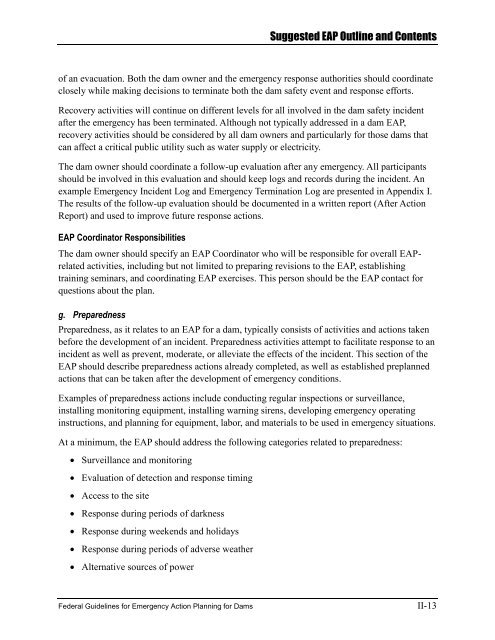Federal Guidelines for Dam Safety: Emergency Action Planning for ...
Federal Guidelines for Dam Safety: Emergency Action Planning for ...
Federal Guidelines for Dam Safety: Emergency Action Planning for ...
Create successful ePaper yourself
Turn your PDF publications into a flip-book with our unique Google optimized e-Paper software.
Suggested EAP Outline and Contentsof an evacuation. Both the dam owner and the emergency response authorities should coordinateclosely while making decisions to terminate both the dam safety event and response ef<strong>for</strong>ts.Recovery activities will continue on different levels <strong>for</strong> all involved in the dam safety incidentafter the emergency has been terminated. Although not typically addressed in a dam EAP,recovery activities should be considered by all dam owners and particularly <strong>for</strong> those dams thatcan affect a critical public utility such as water supply or electricity.The dam owner should coordinate a follow-up evaluation after any emergency. All participantsshould be involved in this evaluation and should keep logs and records during the incident. Anexample <strong>Emergency</strong> Incident Log and <strong>Emergency</strong> Termination Log are presented in Appendix I.The results of the follow-up evaluation should be documented in a written report (After <strong>Action</strong>Report) and used to improve future response actions.EAP Coordinator ResponsibilitiesThe dam owner should specify an EAP Coordinator who will be responsible <strong>for</strong> overall EAPrelatedactivities, including but not limited to preparing revisions to the EAP, establishingtraining seminars, and coordinating EAP exercises. This person should be the EAP contact <strong>for</strong>questions about the plan.g. PreparednessPreparedness, as it relates to an EAP <strong>for</strong> a dam, typically consists of activities and actions takenbe<strong>for</strong>e the development of an incident. Preparedness activities attempt to facilitate response to anincident as well as prevent, moderate, or alleviate the effects of the incident. This section of theEAP should describe preparedness actions already completed, as well as established preplannedactions that can be taken after the development of emergency conditions.Examples of preparedness actions include conducting regular inspections or surveillance,installing monitoring equipment, installing warning sirens, developing emergency operatinginstructions, and planning <strong>for</strong> equipment, labor, and materials to be used in emergency situations.At a minimum, the EAP should address the following categories related to preparedness: Surveillance and monitoring Evaluation of detection and response timing Access to the site Response during periods of darkness Response during weekends and holidays Response during periods of adverse weather Alternative sources of power<strong>Federal</strong> <strong>Guidelines</strong> <strong>for</strong> <strong>Emergency</strong> <strong>Action</strong> <strong>Planning</strong> <strong>for</strong> <strong>Dam</strong>sII-13
















